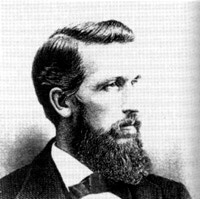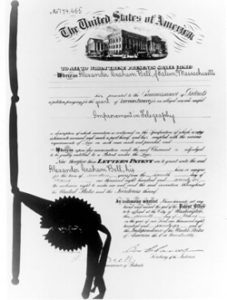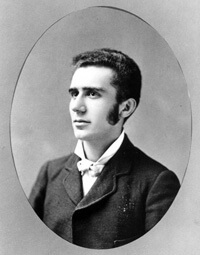Telecommunications History Group Resources
The Science of Phones
The Telephone Patent Follies - The Science of Phones
You can, of course, sell licenses to others allowing them to make or sell or use your invention, or you can keep all these rights to yourself. You can become rich from the proceeds (if, say, you own the patent on the latest, greatest computer chip) or never see a dime.
The patent for the telephone (US patent number 174,465) is widely thought to be the most valuable patent ever granted, which is no real surprise. It is a surprise, however, to discover that the patent very nearly went to Elisha Gray, not to Alexander Graham Bell. (And it may have gone elsewhere–see the sidebar for another claimant to the telephone.)
Watch in Awe as Two Inventors Race to the Patent Office to Register the Most Valuable Patent Ever Issued
It’s February 14, 1876. Valentine’s Day, for those running about with a romantic bent. Nearly one hundred years after the US Declaration of Independence, for those of a more historical nature. If you had been in Boston, Massachusetts, that morning, loitering near the US Patent Office, you may have noticed a man rushing in to file for a patent. This wouldn’t have been Bell himself, but his attorney Marcellus Bailey, there to file for a patent entitled “Improvements in Telegraphy,” and not mentioning the word “telephone.”Having nothing to do for a few hours, and finding yourself still loitering near the patent office, you would have seen another man, Elisha Gray, rushing in to file his Caveat, which announced his intention to file for a patent within three months, for “the art of transmitting vocal sounds or conversations telegraphically through an electric circuit.” (See this link for the full text of Gray’s Caveat.)

Elisha Gray, c. 1878 (from The Telephone Conspiracy of 1876 by A. Edward Evenson, McFarland & Co., Inc., 2000)
Based on that few hours, Bell was granted the patent for the telephone and, despite around 600 lawsuits challenging his patent, he emerged as the man enshrined in all the history books (and with good reason, as we shall see). In fact, it wasn’t the few hours that were the basis of all those lawsuits; instead, the fact that the key to the telephone, variable resistance, was written in the margin of Bell’s application, as though added later (perhaps, it was claimed, after Bell had read Gray’s Caveat, which also included the principle), became a principle issue. Still, the courts consistently found in Bell’s favor.
A lucky thing for Bell was that the patent office didn’t require a working model of the invention. This had been a requirement for any patent application all the way until 1870, but then, for whatever reason, it was dropped and a person could file for a patent with just a description of the invention.
Be Amazed as Edison Pulls Another Bright Idea Out of His Hat
Even after Bell got his telephone working, it wasn’t perfect; the transmitter (the part one spoke into, that then changed sound waves into electrical current) wasn’t powerful enough to operate at great distances (see How Phones Work for more on this). It took Thomas Edison, inventor of a great many things, including the incandescent light bulb and the phonograph, to improve the phone so that it became practical for public use.But because seemingly everything having to do with telephone inventions had to become a legal nightmare, even Edison’s invention (the carbon-based transmitter, eventually used in all telephones through to the 1970s, and a full description of which can be found in How Phones Work) was challenged in court.
Edison filed for his patent for the transmitter on April 27, 1877; this was, however, two weeks after one Emile Berliner filed a Notice of Invention (or Caveat, the same as Gray had done). Berliner, it may be noted, invented the record album, the flat disc used to record and play music before cassette tapes and CDs. It took nearly ten years (until 1886) to resolve the dispute, during which Bell Telephone bought Berliner’s invention and Edison started production of his own transmitter and created The Edison Telephone Company of London Ltd in England to attempt to get around the patent difficulties.This tangled state of affairs was partially resolved when the courts ruled Berliner’s patent claim invalid, as attempting to too broadly encompass the electrical transmission of speech and not applying specifically to Edison’s carbon transmitter (actually, the decision was far more complicated than that, but that’s the gist of it). It was more fully resolved when yet another lawsuit occurred, and then another …
Good Lawsuits
The litigation over the telephone was just beginning on that fateful Valentine’s Day in 1876; there was a lot of love in the air, but it was for the telephone, not for Bell or his patent. There were many more applications for telephone-like devices, and most claimed Bell’s original application was for an object that wouldn’t work as described. Bell and his partners weathered these, but at such a great cost that they tried to sell the patent rights to Western Union, the giant telegraph company, in late 1876 for $100,000.
But Western Union refused, because at the time they thought the telephone would never amount to anything. After all, why would anyone want a telephone? They could already communicate long-distance through the telegraph, and early phones had poor transmission quality and were limited in range.
Western Union’s mind changed within a year as they began to sense the impending importance of the phone, but at that point the rights were no longer offered. Bell and his partners had by then set up the Bell Telephone Company, and business was starting to look quite good indeed.
So Western Union turned around and entered into agreements with Gray, Edison, and others for their inventions, and with the advantages of Edison’s transmitter and an already-existing wiring infrastructure across the country, they looked to become the dominant force in telecom history—which is why, in 1878, Bell’s lawyers sued Western Union for patent infringement.
What made the lawsuit interesting was that both parties owned different patents having to do with the telephone. Bell, of course, had the rights to the telephone itself, plus various rights for the receiver, their own transmitter (inferior to Edison’s), and other bits. Western Union, through Gray and Edison and others, had licenses for the rights to the carbon transmitter and the induction coil (which Bell may have been using in its own phones without permission). And of course Western Union argued that Gray had the real rights to the telephone, and not Bell.
Finally, on November 10, 1879, Bell Telephone won its lawsuit and Western Union was forced to give up its telephone patents (including Edison’s transmitter) and its tens of thousands of phones and subscribers; in return, it received 20 percent of Bell rentals for the 17 year life of Bell’s patents.
The next year, Bell’s victory in the courts was made complete when the British government also ruled against Edison in a lawsuit brought against The Edison Telephone Company of London, and the stage was set for Bell’s emergence as the giant of the telecom business, with 133,000 telephones. The Bell system remained a monopolistic force in the industry in the US until it was forced to break up in 1984.




